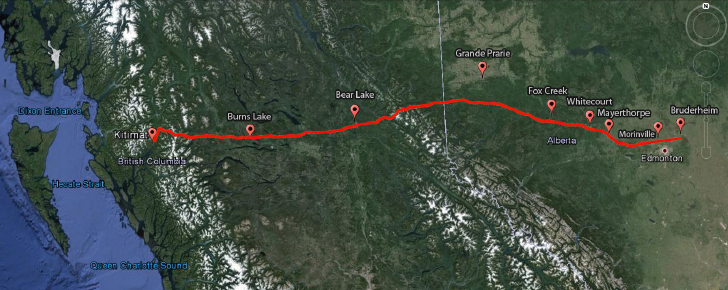The OGM Interactive Edition - Summer 2023 - Read Now!
View Past IssuesA most valuable resource and one of Canada’s major drivers of economic growth and prosperity is crude oil. The proposed Northern Gateway Pipeline project is to utilize this important component of Canada’s wealth and aims to direct Canadian energy towards new oil-thirsty export markets in the Pacific Rim.
Calgary-based company Enbridge is proposing to build a $6.5 billion Northern Gateway pipeline which would carry crude oil from Alberta to the coast of British Columbia, bound for Asian, U.S., and world markets. Currently, 99 percent of all of Canada’s oil exports are going to the United States at discounted prices.
Pending regulatory approval, construction will begin in 2014 with an anticipated completion date in 2018.

The proposed pipeline project consists of
two 1,177 km pipelines running from Bruderheim, AB, to a deep-water port and tank farm in Kitimat, BC.
A westbound oil pipeline which would carry 525,000 barrels of oil per day from Bruderheim to Kitimat.
A eastbound parallel pipeline which would carry 193,000 barrels of condensate per day from Kitimat to Bruderheim.
A terminal at Kitimat with 2 tanker berths, 3 condensate storage tanks, and 16 oil storage tanks. The terminal will be built with world-leading pipeline safety and environmental standards, including a radar-monitoring station and first-response capabilities.
The Northern Gateway pipeline would bring about remarkable economic benefits to all Canadians.
It is expected that operating the Northern Gateway would expand Canadian GDP by more than $300 billion over 30 years, and governments are expected to realize gains of over $80 billion in tax and royalty revenues—which would also mean more funds for Canadian education, health, and infrastructure needs. An estimated 5,500 on-site jobs would be created during the construction phase in BC and Alberta; in addition, about 1,150 long-term jobs would be created to operate the pipelines and marine terminals.
An estimated 380 long-term jobs and nearly 1100 construction jobs are expected for Alberta; in turn, this would boost local goods and services contracts by over $200 million.
Over 3,000 construction jobs and 560 long-term would be created in British Columbia with an estimated $32 million per year of earned income to flow into the local economies.
Northern Gateway is also predicted to generate $1.2 billion in tax revenue for British Columbia and $4.3 billion in labour-related income over the next 30 years.
First Nations and Métis communities were offered equity agreements giving them a 10 percent stake in the pipeline. In addition, the $300 million in estimated employment and contracts adds up to $1 billion in total long-term benefits for Aboriginal communities and businesses.
Previously disturbed lands will make up 70 percent of the pipeline’s route. The pipeline will be dug even deep under watercourses for added protection. The proposed plan includes comprehensive world-class safety prevention, response, and recovery standards. Added measures will be enforced to have as little impact as possible on the terrain, waterways, wildlife, and neighboring communities.
The Joint Review Panel (JPR) of the National Energy Board and the Canadian Environment Assessment has weighed the evidence in the most comprehensive scientific review in Canadian pipeline history and has recommended approval for the project subject to 209 conditions being met before the building of the project and beginning of operations.
The Joint Review Panel stated, “Based on a scientific and precautionary approach to this complex review, the panel found that the project, if built and operated in compliance with the conditions set out in its report, would be in the public interest.”
Those conditions cover everything from protecting caribou habitat to providing research into how the oil would behave in a marine environment, to the company’s spill response plans.
Over $3 million in core funding is allocated for a Gateway Education and Training Fund to support training in construction in B.C. The skills acquired would be transferrable to industries outside of pipeline construction, and consequently help people remain in the workforce after the completion of the project.
Did you enjoy this article?